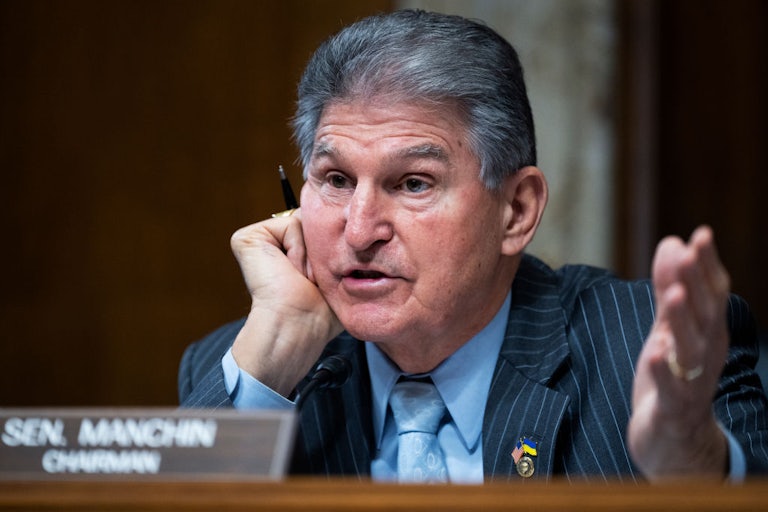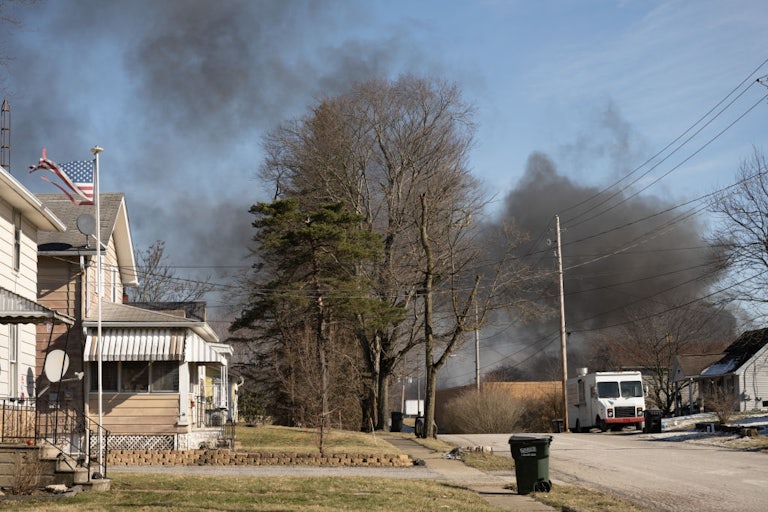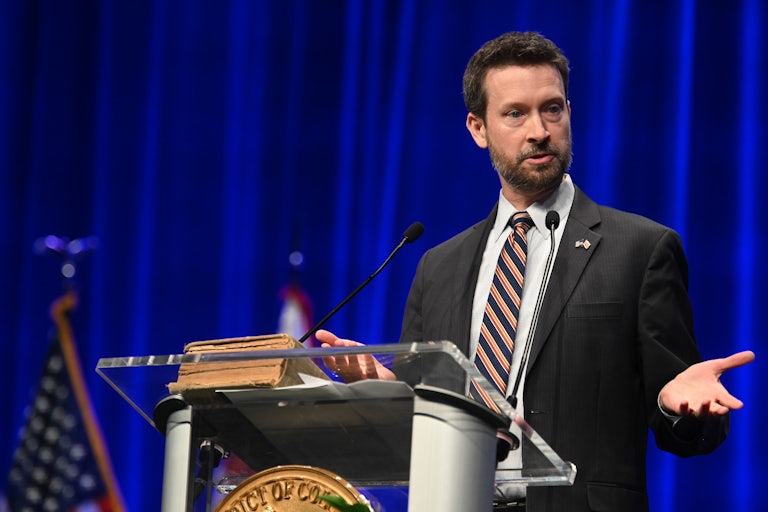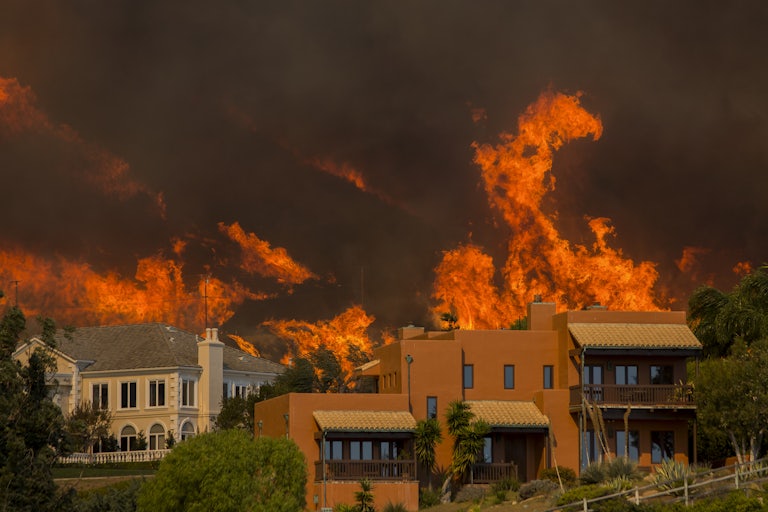Remember When Every Week Was Like This?
Trump’s arraignment was a flashback to that miserable era when he drowned out every policy discussion.

One thought in particular has dominated my mind this week amid the media frenzy of the Trump indictment: Do you remember when every week was like this?
Obviously, not every week literally involved a former president turning himself in for arraignment on 34 felony charges related to misusing campaign funds to pay hush money to an adult film actress. But for entire stretches of the Trump administration, it felt like each day brought a new political tornado, a new scandal, a new baffling situation where it was hard to get answers about what was going on because no one in power seemed to know. As TNR legal writer Matt Ford put it in one memorable, viral tweet in early 2017, “It’s less of a ‘news cycle’ these days and more of that [Battlestar Galactica] episode where the Cylons attack every 33 minutes.”
While Trump, of course, has not exactly faded into dignified, dog-painting retirement like George W. Bush, it’s been easy until the past week to forget what the adrenaline-fueled chaos of his administration felt like. One of the tragedies of that era was that, while the ethics violations, racist rhetoric, and international incidents that dominated headlines were unambiguously worthy of attention, they also made it hard for the average media consumer to get a handle on the Trump administration’s policies—the concrete, substantive legacy of the three-ring circus parked at 1600 Pennsylvania Ave.
So as recent climate news—deadly tornadoes across 14 states, a U.N. report characterized as a “final warning” on global warming, the abrupt reappearance of an inland sea in California—again fades from the headlines this week in favor of Trumpernalia, it seems appropriate to look back at just how many destructive climate and environmental policies got pushed through in those years while the Russia investigation or Melania’s jewelry line competed for the nation’s attention.
Donald Trump began his presidency by making climate denial more or less the official position of the United States government. He did this, TNR’s Emily Atkin observed in 2017, by first nominating a bevy of climate deniers to key positions: Scott Pruitt to lead the Environmental Protection Agency, Rick Perry as energy secretary, Kathleen Hartnett White to the Council on Environmental Quality (this was later withdrawn), and Oklahoma Congressman Jim Bridenstine to head NASA. Meanwhile, Department of Agriculture employees were instructed to avoid the term “climate change” in favor of euphemisms like “weather extremes.”
Before his resignation the following year, Pruitt accrued so many bonkers ethics scandals—a soundproof phone booth, four-figure spending on fountain pens, use of a military helicopter to visit a coal mine, and a really great deal on a Capitol Hill rental owned by an energy lobbyist—that sometimes his policies flew under the radar. In 2018, for instance, Pruitt announced a boring-sounding new rule blocking the EPA from considering studies that contained confidential information about human subjects. The upshot, as Emily Atkin wrote at the time, was that the EPA could no longer use “much of the research showing how pollutants damage public health.… If science based on confidential human health information couldn’t be used by the government,” she wrote, “the tobacco industry likely never would have been subject to strict regulation.” Pruitt also attempted to gut the Obama-era Clean Power Plan, a crusade that his successor, Andrew Wheeler, continued—despite the EPA calculating that this would result in an extra 1,400 premature deaths per year. (The plan was halted by a federal appeals court.)
As the Trump administration entered its final year, Trump’s long-announced withdrawal of the U.S. from the Paris Agreement became official, the Senate passed his climate-hostile replacement to the North American Free Trade Agreement, or Nafta, and his administration’s effort to gut environmental regulations went into overdrive. Miranda Green chronicled the dizzying timeline for TNR that summer:
Since March, the Environmental Protection Agency has weakened mercury air pollution standards, permanently lowered regulations for vehicle tailpipe emissions, and finalized a reinterpretation of the Clean Water Act that opens the door to expedited pipeline development.
At the White House, Trump has been just as busy. In June he signed an executive order that allows companies to bypass key environmental reviews on infrastructure projects like mines and issued a proclamation to allow commercial fishing in a protected monument off Maine’s coast that was created specifically to limit such activity.… As of May 20, [the administration] has revoked, replaced, or weakened 66 environmental rules, according to a count by The New York Times.
By the time of The New York Times’ final update on its deregulation count on Inauguration Day, that list of scrapped environmental rules had risen to 98, with 14 more in progress. Less than a week before Election Day 2020, the administration also attempted to open more of the Tongass National Forest—part of the world’s largest intact coastal temperate rainforest—up to logging.
This isn’t even close to an exhaustive list of Trump-era climate and environmental policy. It’s intended, instead, as an attention exercise. Whether Trump committed multiple felonies during the 2016 presidential election matters. But it’s far too easy, in cases like these, to get sucked into the daily drip of drama that seems to accompany the former president. This court case, even if it results in a conviction and scuppers Trump’s 2024 presidential bid (a long shot), is hardly the final word on the lasting impact of the Trump era. In 2050, as we plausibly approach a once unfathomable two degrees Celsius of global warming, the Trump legacy people may find most appalling is the one which lacked any salacious headlines.
![]()
Good News
European Union countries have approved a law to require all new cars sold starting in 2035 to be zero-emission, despite some controversy.
![]()
Bad News
On the whole, the drought in California is probably not over, despite the deluge of rain in the past few months.
Stat of the Week
That’s how much households currently heated by fuel oil may save on average by switching to an electric heat pump, according to Rewiring America. Check out The Washington Post’s fascinating article (with visuals!) about the geographical divides in U.S. home heating, which cited this number.
Elsewhere in the Ecosystem
“Tornado alley” is shifting farther into the U.S. east, climate scientists warn
Last weekend’s shocking tornado outbreak—over 80 tornadoes across 14 states in the Midwest and Southeast—may be a sign of things to come, The Guardian reports:
Previous research has shown that over recent decades there has been a stagnation, or even slight drop, in the number of tornadoes in their traditional home range of the Great Plains, but an uptick in states further east, such as Tennessee, Mississippi, Alabama, Illinois and Indiana.
These dervish-like storms also appear to be hitting earlier in some instances – tornado season usually starts in spring but parts of the south just had their most active tornado winter season on record and recent research found that milder US winters could be helping spur conditions ripe for earlier storms…. As tornadoes, on average, edge east they are coming into contact with more densely populated areas – think sprawling suburbia more than the isolated Kansas farm in The Wizard of Oz.
Read Oliver Milman’s report at The Guardian.
This article first appeared in Apocalypse Soon, a weekly TNR newsletter authored by deputy editor Heather Souvaine Horn. Sign up here.
.png)

.png)

.png)

.png)

.png)


.png)

.png)

.png)

.png)